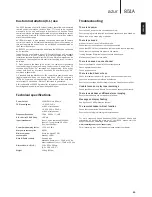
Rear panel connections
1
Power On/Off
Switches the unit on and off.
2
Mains Voltage Selector Switch (CU version only)
Switches the 851A mains voltage between 100V and 115V.
Note:
Intended for use by a professional installer or Cambridge Audio
retailer only.
3
AC power socket
Once you have completed all connections to the amplifier, plug the AC
power cable into an appropriate mains socket then switch on. Your
amplifier is now ready for use.
4
Loudspeaker terminals
Two sets of loudspeaker terminals are available, A (main loudspeaker
terminals) and B (secondary loudspeaker terminals). Both sets of
speakers can be turned on and off independently. Connect the wires
from your left channel loudspeaker to the Left + & - terminals, and the
wires from the right channel loudspeaker to the Right + & - terminals. In
each case, the red terminal is the positive output and the black terminal
is the negative output.
Care should be taken to ensure no stray strands of wire short the
speaker outputs together. Please ensure that the loudspeaker terminals
have been tightened completely to provide a good electrical connection.
It is possible for the sound quality to be affected if the screw terminals
are loose.
Note:
When using two pairs of speakers, use speakers with a minimum
nominal impedance of 16 ohms.
5
IR (Infrared) Emitter In
Allows modulated IR commands from multi-room systems to be
received by the amplifier. Commands received here are not looped out
of the Control Bus. Refer to the ‘Custom installation’ section for more
information.
6
RS232C
The RS232C port allows external serial control of the 851A for custom
install use. A full command set is available on the Cambridge Audio
website at www.cambridge-audio.com. This port can also be used by
Cambridge Audio service personnel for software updates.
7
Control Bus
In
- Allows un-modulated commands from multi-rooms systems or other
components to be received by the unit.
Out
- Loop out for control bus commands to another unit. Also allows the
851A to control some Cambridge Audio units.
8
Preamp Out
Connect these sockets to the inputs on an external power amplifier(s) or
active subwoofers etc.
9
Rec In
Connect to a tape deck or to the analogue output sockets on a MiniDisc,
portable digital music player or CD recorder using an interconnect cable
from the recorder’s Line Out sockets to the amplifier’s Rec In sockets.
The Rec input circuit of the 851A is a “monitor” type, different from the
other 7 inputs. For the 7 normal inputs, the source selected for listening
will be sent out of the Rec Out for recording. The source currently being
listened to and (optionally) recorded is then shown on the front panel
display.
However, when Rec In is selected a solid circle will appear beside REC
IN indicating that the Rec input is now being listened to with a different
source being sent out of the Rec Out for recording. The recording source
is also shown by a solid circle by the selected input and can be changed
by pressing the other source buttons.
To switch Rec input off, simply press the ‘Rec In’ select button again,
toggling this function off.
This feature is most useful when using 3-head analogue cassette decks
which allow the signal being recorded to be played back live off tape
(via a 3rd head) whilst it is simultaneously recorded. It is then possible
by toggling the Rec input on and off to compare directly in real time
the original and recorded signal so that adjustments to the recording
parameters of the tape machine can be made (consult the manual of
your 3-head analogue cassette deck for full details).
Rec Out
For connection to the line level inputs of Tape Recorders or other
analogue recording apparatus.
10
Source 1 & 2 Audio inputs
These inputs feature either unbalanced (phono/RCA) or balanced (XLR)
connections. The balanced connection is the higher quality option and can
reject noise and interference in the cable when used with other equipment
that supports this function. An XLR connector is wired Pin 1 - Ground;
Pin 2 - Hot (inphase); Pin 3 - Cold (phase-inverted).
Note:
Repeatedly pressing the Source 1 or Source 2 buttons on the front
of the unit will toggle these inputs between ‘Balanced’ and ‘Unbalanced’
source inputs.
11
Sources 3-7
These inputs are suitable for any ‘line level’ source equipment such as
CD players, DAB or FM/AM tuners etc.
Note:
These inputs are for analogue audio signals only. They should not
be connected to the digital output of a CD player or any other digital
device.
851A
azur
5
ENGLISH
1
3
4
5
2
6
10
8
11
7
9
































